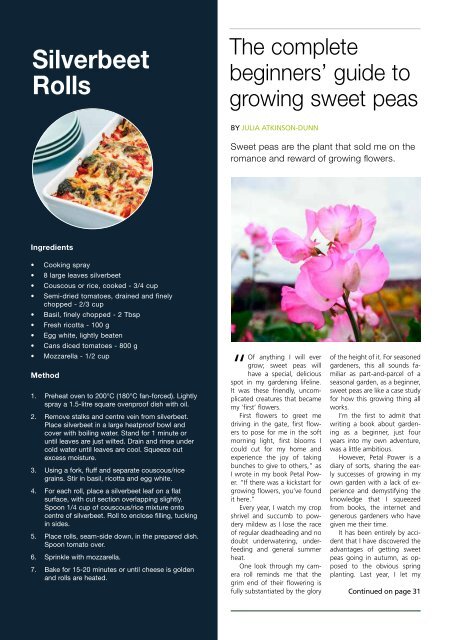Create successful ePaper yourself
Turn your PDF publications into a flip-book with our unique Google optimized e-Paper software.
Silverbeet<br />
Rolls<br />
The complete<br />
beginners’ guide to<br />
growing sweet peas<br />
BY JULIA ATKINSON-DUNN<br />
Sweet peas are the plant that sold me on the<br />
romance and reward of growing flowers.<br />
Ingredients<br />
• Cooking spray<br />
• 8 large leaves silverbeet<br />
• Couscous or rice, cooked - 3/4 cup<br />
• Semi-dried tomatoes, drained and finely<br />
chopped - 2/3 cup<br />
• Basil, finely chopped - 2 Tbsp<br />
• Fresh ricotta - 100 g<br />
• Egg white, lightly beaten<br />
• Cans diced tomatoes - 800 g<br />
• Mozzarella - 1/2 cup<br />
Method<br />
1. Preheat oven to 200°C (180°C fan-forced). Lightly<br />
spray a 1.5-litre square ovenproof dish with oil.<br />
2. Remove stalks and centre vein from silverbeet.<br />
Place silverbeet in a large heatproof bowl and<br />
cover with boiling water. Stand for 1 minute or<br />
until leaves are just wilted. Drain and rinse under<br />
cold water until leaves are cool. Squeeze out<br />
excess moisture.<br />
3. Using a fork, fluff and separate couscous/rice<br />
grains. Stir in basil, ricotta and egg white.<br />
4. For each roll, place a silverbeet leaf on a flat<br />
surface, with cut section overlapping slightly.<br />
Spoon 1/4 cup of couscous/rice mixture onto<br />
centre of silverbeet. Roll to enclose filling, tucking<br />
in sides.<br />
5. Place rolls, seam-side down, in the prepared dish.<br />
Spoon tomato over.<br />
6. Sprinkle with mozzarella.<br />
7. Bake for 15-20 minutes or until cheese is golden<br />
and rolls are heated.<br />
“Of anything I will ever<br />
grow; sweet peas will<br />
have a special, delicious<br />
spot in my gardening lifeline.<br />
It was these friendly, uncomplicated<br />
creatures that became<br />
my ‘first’ flowers.<br />
First flowers to greet me<br />
driving in the gate, first flowers<br />
to pose for me in the soft<br />
morning light, first blooms I<br />
could cut for my home and<br />
experience the joy of taking<br />
bunches to give to others,” as<br />
I wrote in my book Petal <strong>Power</strong>.<br />
“If there was a kickstart for<br />
growing flowers, you’ve found<br />
it here.”<br />
Every year, I watch my crop<br />
shrivel and succumb to powdery<br />
mildew as I lose the race<br />
of regular deadheading and no<br />
doubt underwatering, underfeeding<br />
and general summer<br />
heat.<br />
One look through my camera<br />
roll reminds me that the<br />
grim end of their flowering is<br />
fully substantiated by the glory<br />
of the height of it. For seasoned<br />
gardeners, this all sounds familiar<br />
as part-and-parcel of a<br />
seasonal garden, as a beginner,<br />
sweet peas are like a case study<br />
for how this growing thing all<br />
works.<br />
I’m the first to admit that<br />
writing a book about gardening<br />
as a beginner, just four<br />
years into my own adventure,<br />
was a little ambitious.<br />
However, Petal <strong>Power</strong> is a<br />
diary of sorts, sharing the early<br />
successes of growing in my<br />
own garden with a lack of experience<br />
and demystifying the<br />
knowledge that I squeezed<br />
from books, the internet and<br />
generous gardeners who have<br />
given me their time.<br />
It has been entirely by accident<br />
that I have discovered the<br />
advantages of getting sweet<br />
peas going in autumn, as opposed<br />
to the obvious spring<br />
planting. Last year, I let my<br />
Continued on page 31


















